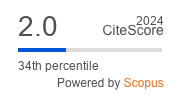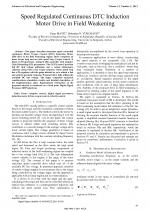| 1/2011 - 16 |
Speed Regulated Continuous DTC Induction Motor Drive in Field WeakeningMATIC, P. |
| Extra paper information in |
| Click to see author's profile in |
| Download PDF |
Author keywords
adaptive control, digital signal processors, induction motor drives, torque control, velocity control
References keywords
induction(11), motor(9), control(9), torque(7), electronics(6), vukosavic(5), flux(5), drive(5), direct(5), weakening(4)
Blue keywords are present in both the references section and the paper title.
About this article
Date of Publication: 2011-02-27
Volume 11, Issue 1, Year 2011, On page(s): 97 - 102
ISSN: 1582-7445, e-ISSN: 1844-7600
Digital Object Identifier: 10.4316/AECE.2011.01016
Web of Science Accession Number: 000288761800016
SCOPUS ID: 79955951373
Abstract
The paper describes sensorless speed controlled continuous Direct Torque Control (DTC) Induction Motor (IM) drive in the field weakening regime. Drive comprises an inner torque loop and an outer speed loop. Torque control is based on Proportional - Integral (PI) controller with adaptive Gain Scheduling (GS) parameters. The GS PI control provides full DC link voltage utilization and a robust disturbance rejection along with a fast torque response. Outer speed loop has a PI regulator with the gains selected so as to obtain a fast and strictly aperiodic response. Proposed drive fully utilizes the available DC bus voltage. The paper comprises analytical considerations, simulation results, and detailed description of the implementation steps. Experimental verification of the proposed solution is conducted on a fixed point Digital Signal Processor (DSP) platform. |
| References | | | Cited By «-- Click to see who has cited this paper |
| [1] D. Casadei, F. Profumo, G. Serra, A. Tani, "FOC and DTC: Two Viable Schemes for Induction Motor Torque Control", IEEE Transactions on Power Electronics, Vol. 17, No.5, pp. 779-787, September 2002. [CrossRef] [Web of Science Times Cited 758] [SCOPUS Times Cited 1094] [2] Z. Sorchini, P. Krein, "Formal Derivation of Direct Torque Control for Induction Machines", IEEE Transactions on Power Electronics, Vol. 21, No.5, pp. 1428-1436, September 2006. [CrossRef] [Web of Science Times Cited 53] [SCOPUS Times Cited 72] [3] Mohamed Bounadja, Ahmed W. Belarbi, Bachir Belmadani, "A High Performance Space Vector Modulation Direct Torque Controlled Induction Machine Drive based on Stator Flux Orientation Technique", Advances in Electrical and Computer Engineering, Volume 9, Number 2, pp. 28-33, 2009. [CrossRef] [Full Text] [Web of Science Times Cited 6] [SCOPUS Times Cited 7] [4] Pavel Brandstetter, Petr Chlebis, Petr Palacky, "Direct Torque Control of Induction Motor with Direct Calculation of Voltage Vector", Advances in Electrical and Computer Engineering, Volume 10, Number 4, pp 17-22, 2010. [CrossRef] [Full Text] [Web of Science Times Cited 24] [SCOPUS Times Cited 30] [5] D. Casadei, G. Serra, A. Tani, L. Zarri, F. Profumo, "Performance Analysis of a Speed Sensorless Induction motor Drive Based on a Constant Switching Frequency DTC Scheme", IEEE Transactions on Industry Applications, Vol. 39, No. 2, March/April 2003. [CrossRef] [Web of Science Times Cited 110] [SCOPUS Times Cited 143] [6] P. Matic, B. Blanusa, S. N. Vukosavic, "A Novel Direct Torque and Flux Control Algorithm for the Induction Motor Drive", IEEE International Electric Machines and Drives Conference, IEMDC'03, Proceedings, Vol. 2, pp. 965-970, 1-4. June 2003. [7] Dj. M. Stojic, S. N. Vukosavic, "A New Induction Motor Drive Based on the Flux Vector Acceleration Method", IEEE Transactions on Energy Conversion, Vol. 20, No. 1, pp.173-180, March 2005. [CrossRef] [Web of Science Times Cited 11] [SCOPUS Times Cited 19] [8] Sergiu Ivanov, "Continuous DTC of the Induction Motor", Advances in Electrical and Computer Engineering, Volume 10, Number 4, pp. 149-154, 2010. [CrossRef] [Full Text] [Web of Science Times Cited 7] [SCOPUS Times Cited 9] [9] Lennart Harnefors, Kai Pietilainen, Lars Gertmar, "Torque - Maximizing Field-Weakening Control: Design, Analysis, and Parameter Selection", IEEE Transactions on Industrial Electronics, Vol. 48, No.1, February 2001. [CrossRef] [Web of Science Times Cited 175] [SCOPUS Times Cited 230] [10] D Casadei, G. Serra, A. Stefani, A. Tani, L. Zarii, "DTC Drives for Wide Speed Range Applications Using a Robust Flux - Weakening Algorithm", IEEE Transactions on Industrial Electronics, Vol. 54, No.5, October 2007. [CrossRef] [Web of Science Times Cited 59] [SCOPUS Times Cited 77] [11] M. Mengoni, L. Yarri, A. Tani, G. Serra, D. Casadei, "Stator Flux Vector Control of Induction Motor Drive in the Field Weakening Region", IEEE Transactions on Power Electronics, Vol. 23, No. 2, pp. 941-949, March 2008. [CrossRef] [Web of Science Times Cited 67] [SCOPUS Times Cited 81] [12] P. Matic, S. N. Vukosavic, A. Rakic, Induction Motor Torque Control in Field Weakening Regime by Voltage Angle Control", 14th EPE-PEMC Conference, Ohrid, 6-8. September 2010. [13] Milic R. Stojic, Slobodan N. Vukosavic, "Design of Microprocessor Based System for Positioning Servomechanism with Induction Motor", IEEE Transactions on Industrial Electronics, Vol. 38, No5, pp. 369-378, October 1991. [CrossRef] [Web of Science Times Cited 6] [SCOPUS Times Cited 10] [14] S. N. Vukosavic, "Digital Control of Electric Drives", Springer, New York, 2007. Web of Science® Citations for all references: 1,276 TCR SCOPUS® Citations for all references: 1,772 TCR Web of Science® Average Citations per reference: 91 ACR SCOPUS® Average Citations per reference: 127 ACR TCR = Total Citations for References / ACR = Average Citations per Reference We introduced in 2010 - for the first time in scientific publishing, the term "References Weight", as a quantitative indication of the quality ... Read more Citations for references updated on 2025-11-16 17:47 in 75 seconds. Note1: Web of Science® is a registered trademark of Clarivate Analytics. Note2: SCOPUS® is a registered trademark of Elsevier B.V. Disclaimer: All queries to the respective databases were made by using the DOI record of every reference (where available). Due to technical problems beyond our control, the information is not always accurate. Please use the CrossRef link to visit the respective publisher site. |
Faculty of Electrical Engineering and Computer Science
Stefan cel Mare University of Suceava, Romania
All rights reserved: Advances in Electrical and Computer Engineering is a registered trademark of the Stefan cel Mare University of Suceava. No part of this publication may be reproduced, stored in a retrieval system, photocopied, recorded or archived, without the written permission from the Editor. When authors submit their papers for publication, they agree that the copyright for their article be transferred to the Faculty of Electrical Engineering and Computer Science, Stefan cel Mare University of Suceava, Romania, if and only if the articles are accepted for publication. The copyright covers the exclusive rights to reproduce and distribute the article, including reprints and translations.
Permission for other use: The copyright owner's consent does not extend to copying for general distribution, for promotion, for creating new works, or for resale. Specific written permission must be obtained from the Editor for such copying. Direct linking to files hosted on this website is strictly prohibited.
Disclaimer: Whilst every effort is made by the publishers and editorial board to see that no inaccurate or misleading data, opinions or statements appear in this journal, they wish to make it clear that all information and opinions formulated in the articles, as well as linguistic accuracy, are the sole responsibility of the author.



